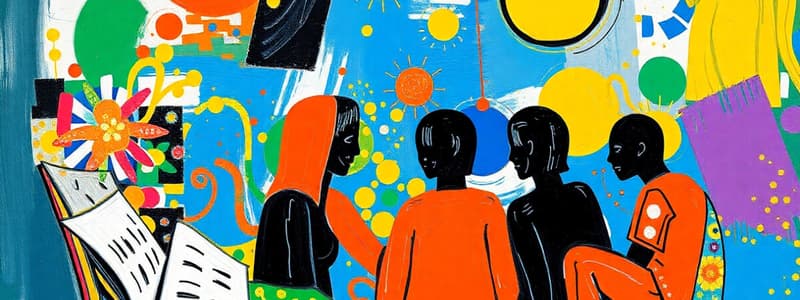Podcast
Questions and Answers
What is one primary benefit of literature circles for learners?
What is one primary benefit of literature circles for learners?
- They develop responsibility among the learners. (correct)
- They increase competition among students.
- They focus solely on individual reading.
- They eliminate the need for teacher involvement.
How do literature circles enhance students' reading comprehension?
How do literature circles enhance students' reading comprehension?
- By eliminating discussions about the text to focus on writing.
- By offering scaffolding to assist with reading difficulties. (correct)
- By allowing only the teacher to guide the discussions.
- By providing an environment focused on individual work.
What characteristic defines the structure of literature circles?
What characteristic defines the structure of literature circles?
- Structured lectures on literature without interaction.
- Individual reflection with no collaboration.
- Small groups of students discussing literature in depth. (correct)
- Large group discussions led by a teacher.
Which statement about the shift in teaching paradigms is correct?
Which statement about the shift in teaching paradigms is correct?
What role does collaboration play in literature circles?
What role does collaboration play in literature circles?
Flashcards
Literature Circles
Literature Circles
Small groups of students discussing a book in detail, guided by their responses. Discussions focus on events, characters, author's style, or personal connections.
Benefits of Literature Circles
Benefits of Literature Circles
Increased learner responsibility, total participation, collaboration, improved comprehension, renewed teaching/reading excitement, and safe space for discussion.
Differentiated Literature
Differentiated Literature
Adapting teaching methods to suit individual student needs and learning styles
Learner-centered Classroom
Learner-centered Classroom
Signup and view all the flashcards
Challenges of Literature Circles for Beginning Teachers
Challenges of Literature Circles for Beginning Teachers
Signup and view all the flashcards
Study Notes
Course Information
- Course name: EDENG 102
- Instructor: Lynou R. Zacal, Ph.D
Objectives
- Students will explain the benefits of differentiated literature circles through oral recitations.
- Students will analyze challenges beginning teachers face in using literature circles correctly using a matrix.
Philippine Professional Standards for Teachers
- BT1.1.1: Demonstrate content knowledge and its application within and across curriculum teaching areas.
- BT1.3.1: Show skills in the positive use of ICT to facilitate the teaching and learning process.
- BT4.4.1: Seek advice concerning strategies to enrich teaching practice.
Introduction
- Teaching paradigm has shifted from teacher-centric to learner-centered.
- Communication and collaboration should develop among learners while increasing literacy levels.
- Teachers should modify teaching methods creatively and proactively for their classes.
Literature Circles
- This lesson aims to help understanding the blocks, principles and modifications of literature in a classroom.
- The video discusses the benefits, functions, and implementation, including assigned roles, like discussion director, connector, passage predictor, artistic artist, etc. in literature circles.
- Literature circles involve small groups discussing a piece of literature in depth, guided by student responses.
- Literature circles promote critical thinking, reflection, and responding to books through collaborative discussions.
- The methodology stems from Rosenblatt's Transactional Theory (1978).
- Literature circles are enjoyed, especially in intermediate grades, due to socialization opportunities.
Literature Circles Benefits
- Develops learner responsibility by increasing participation
- Promotes collaboration among team members
- Provides scaffolding to break reading difficulties and enhance comprehension
- Rejuvenates excitement about literature reading, invoking eagerness.
- Helps learners learn appropriate responses and comprehension strategies.
- Relieves pressure to perform in group conversations by providing a safe and intimate environment.
Literature Circles Functions
- Discussion Director: Leads the group during reading stops, questions, and starts reading aloud.
- Creative Connector: Connects the text to other texts, themselves, and the world.
- Passage Predictor: Predicts what will happen next in the section.
- Artistic Artist: Illustrates and captions a piece.
- Super Summarizer: Summarizes main events, characters, and settings.
- Word Wizard: Identifies new words and definitions.
How to Implement Literature Circles
- Form groups of 4-8 members.
- Assign individual roles.
- Give each member a copy of the literary piece.
- Read aloud some parts of the piece, explaining each member's function during reading.
- Present thought-provoking questions to stimulate debate acting as a roadmap.
Video 2
- Observe the video on literature circle classroom and take notes for use in the tasks.
Task 1
- Identify three challenges in using literature circles using a matrix.
- Identify solutions to said challenges.
Task 2
- Write five essential tips for using literature circles.
Task 3
- Reflect on what was learned, the need for change, and how to apply the knowledge.
Assignment
- Explain the story's conflict.
- Name and explain at least two cultural traits or practices in the story.
Studying That Suits You
Use AI to generate personalized quizzes and flashcards to suit your learning preferences.




